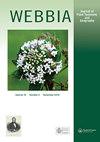Germination capability of four charophyte populations (Characeae) from Mediterranean brackish ponds under warm experimental conditions
Q3 Agricultural and Biological Sciences
引用次数: 1
Abstract
ABSTRACT The diaspore banks from two brackish ponds within the Albufera de València Natural Park (Spain) containing oospores of Chara hispida, C. aspera, C. canescens and Nitella hyalina were analysed and their germination capability studied under controlled temperature conditions. The top layer of sediment from each meadow was collected and sequentially sieved to isolate the charophyte oospores, subsequently identified and counted under the microscope. The density of apparently viable fructifications varied largely within the studied ponds and within specific meadows. In general, but not always, the most abundant oospores belonged to the species forming the meadow. An additional set of surficial sediment samples were collected to perform germination trials in an indoor culture room under three temperature treatments (21, 25 and 29°C). For each species, 219–272 fructifications were allocated inside small perforated packages that were placed in Petri dishes (n = 3) and submerged for 40 days in plastic containers. Germination rates were low for the four species in all temperatures (0–7%), with no large differences detected amongst treatments. C. aspera was the first species to germinate and the one with the most germlings. Higher temperatures negatively affected its germination; the same trend was shown by C. canescens. Dense oospore banks and low germination rates have been previously described for charophytes from temporary habitats. However, it seems that the recovery of charophyte meadows after droughts will be hindered by a warmer climate. Further studies concerning the optimal conditions for germination are needed to understand the future capability of charophyte meadows to re-establish in Mediterranean ecosystems.地中海半咸淡水塘四种蕨类植物种群在温暖实验条件下的萌发能力
摘要分析了西班牙Albufera de val ncia自然公园内两个半淡水池塘中含有Chara hispida、C. aspera、C. canescens和Nitella hyalina卵孢子的一水硬石库,并研究了它们在控制温度条件下的萌发能力。收集每个草甸的最上层沉积物,依次筛选以分离绿藻卵孢子,随后在显微镜下进行鉴定和计数。在研究的池塘和特定草甸内,明显有活力的果实密度变化很大。一般来说,但并非总是如此,最丰富的卵孢子属于形成草甸的物种。另外收集一组表层沉积物样品,在室内培养室中进行三种温度处理(21、25和29°C)下的萌发试验。对每个物种,219-272个果实被分配在小穿孔包装中,放置在培养皿中(n = 3),并在塑料容器中浸泡40天。4种植物在不同温度下的发芽率均较低(0 ~ 7%),处理间差异不大。青霉是最早发芽的种,也是萌发量最多的种。高温对其萌发有不利影响;C. canescens也表现出同样的趋势。密集的卵孢子库和较低的发芽率已经被描述为来自临时栖息地的蕨类植物。然而,干旱后的草甸恢复似乎会受到气候变暖的阻碍。需要进一步研究草甸萌发的最佳条件,以了解草甸在地中海生态系统中的重建能力。
本文章由计算机程序翻译,如有差异,请以英文原文为准。
求助全文
约1分钟内获得全文
求助全文

 求助内容:
求助内容: 应助结果提醒方式:
应助结果提醒方式:


